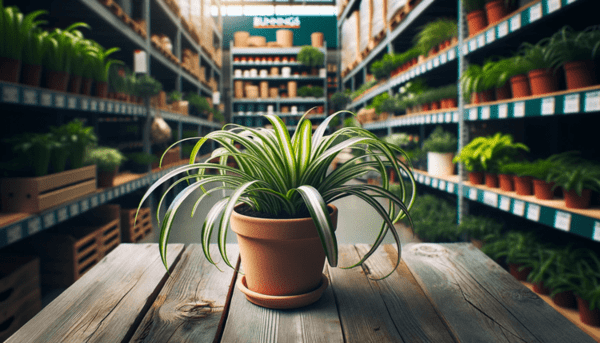
spider plant
Information for the customer:
- Plant Life Cycles: perannial
- Plant Position: indoor , potted
- Soil Type: well draining , porous , all purpose
- Common Diseases: root rot
- Common Pests: aphids , spider mites
- Watering Needs: low-moderate: anytime between weekly and monthly
- Shade Requirements: yes
- Lighting Requirements: less/average light: 25% - 50% of daily sun
- Pet Child Friendly: yes
- Air Purifying: yes
- Humidity Needs: moderate
Helpful Tip:
- Helpful Tip: Allow topsoil to dry between waterings; avoid direct sunlight
Potting Sizes and Info:
- Maximum Growing Height: 60cm
- Suitable For Hanging: yes
Additional Facts and Info:
- Scientific Name: chllorophytum comosum
- Native To: south africa
Extensive Info on the spider plant:
How do you take care of a Spider plant?
Location
The Spider plant likes to be placed in a spot with lots of light. It is best to place the plant in medium bright light. The Spider plant prefers a spot next to a window on the west or east. A spot near the south is of course also possible. Make sure that the plant is at least 2 metres away from the window. A spot near the north probably has too little light. Don’t forget to turn the Spider plant! The plant grows towards the sun. If you do not rotate the plant will only get full on one side and that is what you want to prevent.
Watering
It is important to always keep the soil of the Spider plant slightly moist. You can check this with your finger in the soil. Never let the Spider plant dry out. Not even in winter! It is best to water the Spider plant 2 to 3 times a week in the growing season, from spring to autumn. In the winter once a week is enough.
Plant nutrition
The Spider plant uses a lot of energy from spring onwards to make new leaves. As a result, the plant needs extra nutrients. You can provide these nutrients by means of plant nutrition. We recommend giving plant nutrition once a month. From spring until autumn. After autumn and in winter it is better not to give extra nutrients. In the autumn, plant nutrition can actually be harmful for the Spider plant!
Repotting
Repotting the Spider plant is necessary every 2 years. Repotting the plant every 2 years gives it new nutrients and more room for root growth. The airier soil is also very good for the water flowing through. The best period to repot is spring.
Air-purifying
Spider plant is a good air-purifying plant. This is mainly due to the long leaves of Spider plant. The leaf surface gives the plant extra stomata. The Spider plant uses these stomata to convert CO2 into oxygen during the day. And that is always good. For you and your home.
Is the Spider plant toxic?
They are not poisonous to humans or pets, making them the perfect choice for indoor plants.
Diseases and peculiarities
If the air is too dry, the Spider plant can suffer from mites. To prevent mites, it is best to use the plant sprayer once a week. Mites are an infection of mites on plants. You can recognize the infection by infected leaves and a kind of cobwebs. If you have come across mites, it is best to place the plant outside. Wind and moisture from outside will quickly keep the mites away.
Frequently asked questions about the Spider plants
Why does my Spider plant grow long stems?
If a Spider plant gets too little sunlight, the plant will grow long stems. The reason for this? Because of the long stems the plant hopes to reach the sunlight. However, this can be crucial for the plant. Because of the long stems the leaves can become too heavy and break off.
Why does my Spider plant get brown tips?
When the environment of the spider plant is too dry, the tips can become brown and dry. If you notice these brown spots, it is wise to water the plant regularly.
My Spider plant gets brown leaves, what should I do?
When you see that the spider plant gets brown leaves, it is often because of the watering. Too much water can cause brown spots in the heart of the plant. In this case it is wise to check whether the plant is suffering from root rot.
The leaves of my Spider plant become dull, how is this possible?
When Spider plants get dull leaves, this is usually due to a lack of light or nutrition. The easiest thing to do is to move the plant to a location with more light.
Why doesn't my Spider plant have shoots?
It can have several reasons that the spider plant does not produce shoots. The most common reasons are:
Too much sunlight: When the spider plant gets (too much) direct sunlight it can burn its leaves. In this case, the plant spends its energy on the preservation of its leaves, instead of for new shoots.
Not enough water: Keep an eye on the water level of the spider plant. The plant needs water to grow and develop new shoots. Root suffocation: Have you never repotted your Spider plant? Maybe it is wise to repot the spider plant. If the roots have little or no room to grow, new shoots will not appear. To stimulate new shoots you can also prune the spider plant. Can you propagate a Spider plant? Yes, you certainly can. See our tips on how to propagate the Spider plant.